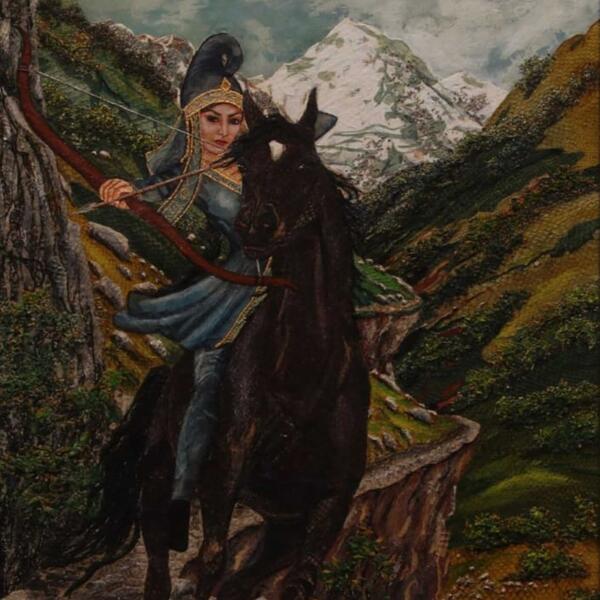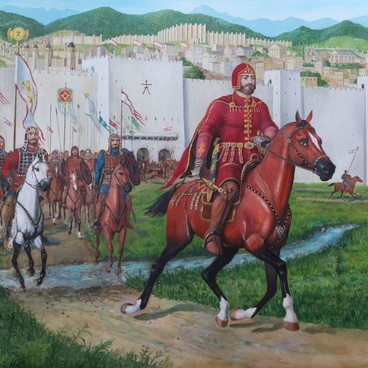Lida Ozdoeva creates her artworks using the rarest technique — she puts together pieces of colored and processed fish skins and assembles them into a mosaic.
For the first time, the artist tried to work with this material thanks to entrepreneur Akhmed Shadiev — he was one of the first in the world to develop the technology for production of fish skin leather. In the 2010s, his factory (‘Shadi’) in Nazran produced belts, bags, shoes, and many other items made of seven types of commercial fish species. The inventor liked the artistic vision of the young woman and gave her several pieces of raw materials in different shades so that she could use them for her art.
That is how the artist fell in love with this rare material. These days, she chooses different fish skins for each artwork: squid, salmon, sturgeon. For example, the craftswoman mentioned that it is better to make the sky using squid because the width of its skin lets her imagination run freely, while working with salmon could be difficult as it is not always possible to choose the right width.
On her artwork ‘The Amazon’, Lida Ozdoeva depicted a warrior woman with a war bow, using different fish skins.
Many Ingush legends, as well as ancient Greek myths, tell stories about ‘the free and proud women’ who lived high up in the mountains. It was believed that in the ancient times, the amazons inhabited the Don River and from there they started their conquering campaigns: the Amazons moved along the shores of the Black Sea to the Danube; their paths also included the territories from the Caucasus to the southern coast of the Black Sea.
According to the legends, the female warriors were famous for their riding skills and the arts of combat. Soldiers who had fought them said the Amazons knew no fear, they could not be put to flight — they fought to the death.
Lida Ozdoeva created ‘The Amazon’ and based it on the Ingush legends. She portrayed a female warrior in the Caucasus Mountains. Interestingly, the artist usually creates landscapes using her imagination, and never simply copies natural landscapes. However, she carefully and realistically conveys the beauty of Ingushetia: mountain trails, snow-capped peaks, recognizable vegetation. Therefore, on this canvas, the horsewoman is surrounded by juniper and sea buckthorn, and, in the background, one can see pine trees and linden trees on the steep slopes.
For the first time, the artist tried to work with this material thanks to entrepreneur Akhmed Shadiev — he was one of the first in the world to develop the technology for production of fish skin leather. In the 2010s, his factory (‘Shadi’) in Nazran produced belts, bags, shoes, and many other items made of seven types of commercial fish species. The inventor liked the artistic vision of the young woman and gave her several pieces of raw materials in different shades so that she could use them for her art.
That is how the artist fell in love with this rare material. These days, she chooses different fish skins for each artwork: squid, salmon, sturgeon. For example, the craftswoman mentioned that it is better to make the sky using squid because the width of its skin lets her imagination run freely, while working with salmon could be difficult as it is not always possible to choose the right width.
On her artwork ‘The Amazon’, Lida Ozdoeva depicted a warrior woman with a war bow, using different fish skins.
Many Ingush legends, as well as ancient Greek myths, tell stories about ‘the free and proud women’ who lived high up in the mountains. It was believed that in the ancient times, the amazons inhabited the Don River and from there they started their conquering campaigns: the Amazons moved along the shores of the Black Sea to the Danube; their paths also included the territories from the Caucasus to the southern coast of the Black Sea.
According to the legends, the female warriors were famous for their riding skills and the arts of combat. Soldiers who had fought them said the Amazons knew no fear, they could not be put to flight — they fought to the death.
Lida Ozdoeva created ‘The Amazon’ and based it on the Ingush legends. She portrayed a female warrior in the Caucasus Mountains. Interestingly, the artist usually creates landscapes using her imagination, and never simply copies natural landscapes. However, she carefully and realistically conveys the beauty of Ingushetia: mountain trails, snow-capped peaks, recognizable vegetation. Therefore, on this canvas, the horsewoman is surrounded by juniper and sea buckthorn, and, in the background, one can see pine trees and linden trees on the steep slopes.





